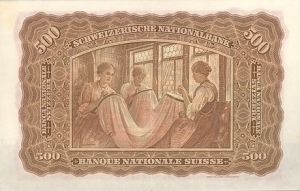Although hand embroidery was already a major industry in the region by the eighteenth century, the development of the embroidery production in St. Gallen was stimulated by the invention of the hand embroidery machine by Joshua Heilmann of Mulhouse in 1828 and the setting up of embroidery machine factories in and around St. Gallen. Nowadays, there are some nine large companies producing computer-driven machine embroidery imitating hand embroidery, while there are some smaller companies left that still operate in the traditional manner with hand embroidery machines.
St. Gallen embroidery is also known as Swiss whitework or simply Swiss embroidery.
See also the TRC Needles entry on the Textile Museum, St. Gallen.
Digital source of illustration (retrieved 10th May 2017).
WV

